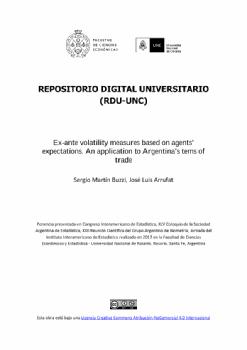| dc.contributor.author | Buzzi, Sergio Martín | |
| dc.contributor.author | Arrufat, José Luis | |
| dc.date.accessioned | 2021-09-12T23:16:49Z | |
| dc.date.available | 2021-09-12T23:16:49Z | |
| dc.date.issued | 2017-10 | |
| dc.identifier.issn | 2591-3980 | |
| dc.identifier.uri | http://hdl.handle.net/11086/20280 | |
| dc.description.abstract | In this paper we discuss the construction of volatility measures aimed to reflect the ex-ante uncertainty faced by economic agents. The most widely used volatility measure is the standard deviation of the original time series. This measure no doubt has some merit given that the future values of a series with high variability is probably more difficult to predict than future values from a series which is less variable. But, the raw standard deviation implicitly assumes that economic agents cannot anticipate any component of the series. However, if agents perceive a portion of the data generation process, they are surprised only by the unpredictable component. Following, volatility measures based in the unpredictable components can be built in order to obtain a better proxy for agents? true uncertainty. In order to do that, volatility measures are computed using the residuals from a set of predictive models. Each one of those models can be viewed as an alternative assumptions made about the expectation formulation process faced by economic agents. Then, assuming different models of expectation formulation, volatility indices are built removing the components of total fluctuations that are predictable, and measuring the variability of the unpredictable component. Almost all the previous literature following this line, computes volatility using the residuals from a predictive equation estimated for the full sample period under study; but as we noted in Arrufat et al. (2014), economic agents cannot base their forecasts using data from the unseen future, that is, the predictive model only can be based on the data available at the moment when the forecast is made. A practical procedure to avoid the latter problem is to implement a rolling window estimation algorithm, on which agents formulate their predictions for next period based upon the k most recent periods. Finally, the alternative indices built are employed to compute the volatility of the Terms of Trade (TOT) of Argentina and the estimates are compared in order to conclude if they follow different paths. | es |
| dc.format.medium | Electrónico y/o Digital | |
| dc.language.iso | eng | es |
| dc.rights | Atribución-NoComercial 4.0 Internacional | * |
| dc.rights.uri | http://creativecommons.org/licenses/by-nc/4.0/ | * |
| dc.subject | Volatility | es |
| dc.subject | Uncertainty | es |
| dc.subject | Rolling window | es |
| dc.subject | Time series | es |
| dc.title | Ex-ante volatility measures based on agents' expectations. An application to Argentina's tems of trade | es |
| dc.type | conferenceObject | es |
| dc.description.fil | Fil: Buzzi, Sergio Martín. Universidad Nacional de Córdoba. Facultad de Ciencias Económicas; Argentina. | es |
| dc.description.fil | Fil: Arrufat, José Luis. Universidad Nacional de Córdoba. Facultad de Ciencias Económicas; Argentina. | es |
| dc.description.field | Economía, Econometría | |
| dc.conference.city | Rosario | |
| dc.conference.country | Argentina | |
| dc.conference.editorial | Sociedad Argentina de Estadística | |
| dc.conference.event | I Congreso Interamericano de Estadística | |
| dc.conference.eventcity | Rosario | |
| dc.conference.eventcountry | Argentina | |
| dc.conference.eventdate | 2017-10 | |
| dc.conference.institution | Sociedad Argentina de Estadística | |
| dc.conference.journal | Anales del I Congreso Interamericano de Estadística | |
| dc.conference.publication | Libro | |
| dc.conference.work | Resumen | |
| dc.conference.type | Congreso | |





